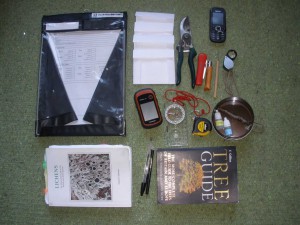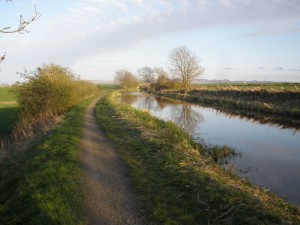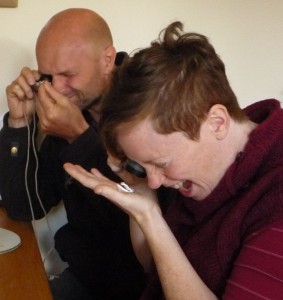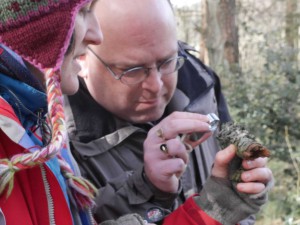
With trees, bushes and undergrowth exploding into colour and new life, this is a glorious time to be out and about. This month has been a month of surveying. With two and a bit months of beginning to get to grips with lichen identification, I have headed out more days than not into the field, well street actually, to survey lichens as part of my Lichens as Air Quality Monitors project.
There is a long history of research about lichens as biological monitors of air quality, so I am not trying to break new ground as such. But as part of the incredibly exciting new initiative – the Edinburgh Living Landscape (ELL), which aims to increase urban biodiversity, link up green spaces and make the city a more biologically rich and pleasant place for people and wildlife, I am researching whether or not there are ‘specific to Edinburgh lichens’ which can tell us something about the local air quality within the city. Whatever the result, a raised public awareness of these often un-noticed species and their role in empowering local people and communities through an understanding of the link between lichens, air quality, and human and environmental health, is top of the agenda.
Surveying at this stage in my traineeship is an exciting but steep learning curve. Heading out to identify every epiphytic lichen (those growing on trees) that I can see on the four chosen trees at each of my monitoring sites is a challenging proposition. Not least because many of the lichens found in the city may be new colonisers and therefore tiny; they may be half or more than half munched by slugs and other insects, and they are often covered or distorted by a film of algae or black soot. All of which make the observation of certain characteristics for identification somewhat tricky!
I am surveying 26 sites, dictated by the location of the Scottish Automatic Urban & Rural Network of Air Quality Monitoring Stations (AURNS) which are distributed in and around Edinburgh, the Lothians and beyond. My sites are all on the east side of the central belt due to the potential impacts of climatic variation on lichen distributions.

The essentials for lichen surveying, plus un-photographed equally essential items such as – camera, notebook, a hearty packed lunch, thermos flask, hat, gloves & waterproofs!
Sites range from a bog in the wilds south of Pencuik, to tiny urban, dog filled parks,and to the concrete jungle that is Salamander Road in north-east Edinburgh. I have ventured north as far as Cupar, over to Stirling and down to Peebles. Much of my time has been spent on and around pavements on the sides of busy main roads. It’s not glamorous, but it is fascinating!! And being so much in the public view does give rise to some interesting conversations – all opportunities to engage the public in the role of lichens as air quality indicators. So far my surveying travels have seen me engaging with carpenters, pub owners, pub regulars, office workers, parents, bakers, home owners, the police, builders, health workers and families – and I haven’t even started the public engagement part of my traineeship officially yet!!
Inbetween the surveying I get to discover new places along the way as I make my way in and around the Eastern central belt.
And traveling by public transport – bike, train and bus makes complete sense when I am seeing first-hand some of the impacts of air pollution, which in Edinburgh is mainly from motorised vehicles and the sheer number of cars on the road…

Source: www.telegraph.co.uk
As I travel around Edinburgh and the Lothian’s I think of what it all means, and how best to facilitate awareness and engagement of lichens and foster connections about the impacts of our daily actions on the health of our environment, and therefore ourselves through the production air pollution.
One thing that becomes clear is the need to ‘make the invisible visible’ – and lichens are the perfect thing to do just that, as they make the invisible air pollution visible by their presence or absence on trees.
Secondly, after a fanastic day supporting our very own TCV OPAL community officer to deliver some OPAL surveys and engagement work around lichens as part of a support scheme called Branching Out, I am convinced that just getting people oogling down a hand lens at the incredible hidden world of lichens is a very good start!






